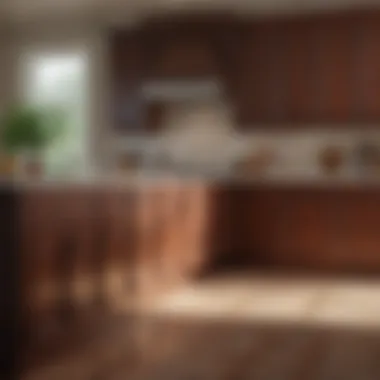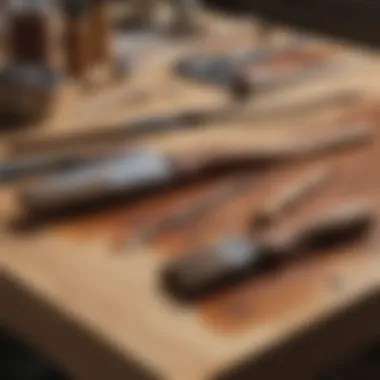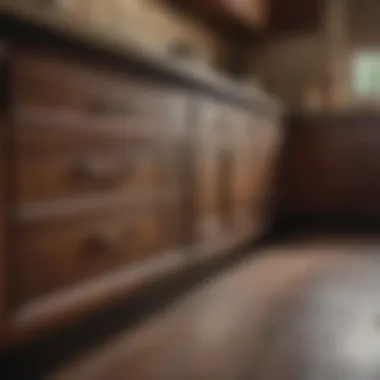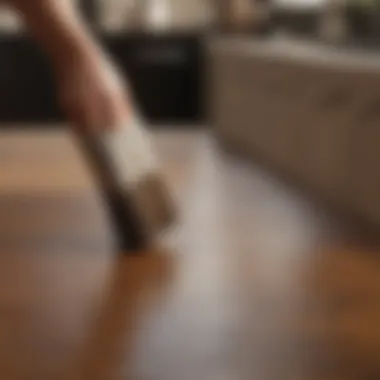A Complete Guide to Staining Kitchen Cabinets


Intro
Staining kitchen cabinets can transform your culinary space. This practical guide addresses all necessary steps for achieving a professional look. The process is not just about aesthetics; it is also about maintaining the value of your home.
Understanding the relevance of this task is crucial. Many homeowners want to refresh their kitchens without a full remodel. The right stain can breathe new life into outdated cabinets. This guide will cover essential techniques and materials. From selecting stains to applying them, every detail is vital for achieving satisfactory results.
Design Inspirations
Trending Styles
Design trends play an important role in choosing the right stain. In 2023, trends lean toward natural finishes that highlight the grain of the wood. Light stains, such as whitewash or honey oak, create an airy feel. Darker hues, like espresso or charcoal, add sophistication.
When selecting a style, consider the overall theme of your kitchen. For modern kitchens, a glossy finish may work best. More traditional spaces might benefit from a matte finish that brings out the character of the wood.
Color Palettes
Choosing the right color palette is essential for a harmonious kitchen. Neutral tones serve as a solid foundation. Colors like taupe or soft grey can complement wood stains beautifully. Pair these with brighter accents for a balanced look.
You can also opt for vibrant colors to make a statement. Deep blues or emerald greens can create a stunning contrast against stained cabinets. Ultimately, the choice of color should reflect your personality and the feel you want for your kitchen.
Maintenance and Upkeep
Proper maintenance ensures that your stained cabinets remain beautiful over time. Regular inspection is necessary to spot any issues early, especially if you host parties or have children.
Seasonal Maintenance Checklist
- Inspect for any scratches or damage.
- Clean surfaces gently with a damp cloth.
- Reapply protective coatings if necessary to preserve the stain.
Cleaning and Organization Tips
- Use mild soap and water for routine cleaning.
- Avoid harsh chemicals that may damage the stain.
- Organize kitchen tools to minimize clutter, which helps maintain the cabinets' clarity.
Remember, the way you care for your cabinets directly impacts their longevity and appearance.
In summary, staining kitchen cabinets is not just a surface task but a meaningful home improvement project. By considering design inspirations, choosing the right colors, and practicing diligent maintenance, you can enjoy a fresh, enhanced kitchen for years to come.
Foreword to Cabinet Staining
Staining kitchen cabinets is an essential task for many homeowners looking to enhance the beauty of their space. This process not only changes the appearance of the wood but can also protect and preserve it, extending the life of your cabinetry. Proper staining can bring out the natural grain of the wood, adding depth and character to the kitchen.
Understanding how to stain cabinets effectively can transform an outdated kitchen into a vibrant environment. It is an opportunity to express creativity while also providing a long-lasting finish. The topic of cabinet staining, therefore, goes beyond aesthetics; it holds practical implications for maintenance and durability in high-use areas like kitchens.
What is Cabinet Staining?
Cabinet staining is the process of applying a colored finish to wooden cabinets to enhance their beauty. Unlike paint, which can cover the wood grain completely, stains penetrate into the wood fibers, allowing the natural patterns of the wood to show through. This method can vary in technique and material, depending on the desired outcome.
There are several types of stains available, including oil-based, water-based, and gel stains. Each type offers unique properties that may suit different preferences and applications. For instance, oil-based stains tend to provide a richer finish but may take longer to dry, whereas water-based stains dry quickly and reduce odor. Understanding these differences is crucial for selecting the right stain for your kitchen cabinets.
Benefits of Staining Over Painting
Staining offers distinct advantages when compared to painting, particularly for kitchen cabinetry. Some of these benefits include:
- Enhancing the Natural Beauty of Wood: Staining allows the wood's texture and grain to remain visible, creating a more organic look that many people prefer.
- Ease of Application: Applying stain can often be simpler than paint. Stains typically require fewer coats, reducing time and effort in the process.
- Fewer Maintenance Concerns: Stained surfaces do not chip like painted surfaces, which can maintain their appearance for a longer duration with proper care.
- Variety of Looks: Stains come in numerous colors and finishes, enabling customization that fits diverse design styles. Different shades help match or contrast with other elements in the kitchen.
Overall, cabinet staining represents an effective way to achieve a fresh look in your kitchen, while also protecting the underlying wood.
"The right stain can completely change your kitchen's ambience, creating a warm and inviting space that feels both modern and homey.”
By choosing to stain rather than paint, one can create a sophisticated finish that elevates the kitchen's design.
Understanding Wood Types
Understanding the types of wood used in kitchen cabinets is crucial when considering staining. Each wood type has its unique characteristics, influencing how it absorbs stain, its final appearance, and its durability. Knowledge of these materials helps homeowners make informed decisions, resulting in a richer aesthetic and longer-lasting results. Moreover, different woods also affect the tools and techniques needed for optimal staining.


Common Kitchen Cabinet Materials
Kitchen cabinets are typically made from a few common materials, each with distinct attributes:
- Plywood: This material is known for its strength and stability. It consists of thin layers of wood veneer, bonded together. Plywood takes stain well, but some finishes can raise the grain, requiring careful sanding.
- MDF (Medium-Density Fiberboard): MDF is engineered from wood fibers, making it dense and smooth. It is better suited for painting than staining due to its non-porous surface. Staining MDF usually leads to uneven results, so this material might require a different approach.
- Solid Wood: Solid wood cabinets can be built from various species, including oak, maple, cherry, and walnut. Each type offers unique grain patterns and color variations, making it a favorite for homeowners who desire depth in their staining.
- Particleboard: Often used due to its low cost, particleboard is less ideal for staining. Its surface is not as receptive to stains, presenting a challenge for achieving a uniform look.
Understanding these materials allows you to select the right staining products and techniques appropriate for your kitchen cabinets.
How Wood Type Affects Staining
The type of wood directly affects the staining process in several ways:
- Porosity: Softwoods like pine absorb stains differently compared to hardwoods like oak. This difference can lead to varying saturation levels, resulting in either a lighter or darker finish than anticipated.
- Grain Pattern: The grain of the wood can enhance or detract from the final look. For instance, woods like oak have an open grain that can give a textured appearance, while closed-grain woods like maple provide a smoother finish.
- Natural Oils and Resins: Some woods contain natural oils and resins (such as cedar and teak) that can hinder stain absorption. Applying a pre-stain wood conditioner can help mitigate this issue, ensuring that the stain adheres evenly.
- Color and Tone: Different woods exhibit different natural colors. For example, cherry darkens over time, while maple tends to lighten. This inherent characteristic should be considered when choosing stain colors to align with desired final aesthetics.
The right stain applied to a suitable wood type can enhance the beauty of cabinets while providing protection.
Being aware of these factors aids in selecting an appropriate stain and application method. Each wood type presents various challenges and opportunities, making it essential to match your choice with the desired visual outcome.
Choosing the Right Stain
Selecting the right stain for your kitchen cabinets is an essential step that can significantly influence the outcome of your project. It determines not only the final appearance but also the durability and maintenance requirements of the cabinets. Considering the various stain types and their characteristics will lead to a more satisfactory finish and prolong the lifespan of your kitchen cabinetry.
When choosing a stain, it is important to balance aesthetics with functionality. You want a color that complements your kitchen's design while ensuring the finish withstands wear and tear from everyday use. The right stain enhances the natural beauty of the wood while providing a protective layer against moisture and damage.
Oil vs. Water-Based Stains
Oil-based stains and water-based stains each have unique features that make them suitable for different projects. Choosing between these options often impacts the application process and the final look of the cabinets.
Oil-based stains penetrate deeper into the wood, offering a rich coloration that accentuates the grain. They generally provide excellent durability, making them ideal for high-traffic areas like the kitchen. However, they have a longer drying time and a stronger odor, which can be a consideration if you're staining in a closed space. Maintenance of oil-based stains can also be more demanding, as they may require a specific topcoat to enhance their longevity.
Water-based stains, on the other hand, are easier to clean up and typically dry more quickly. This trait allows for multiple coats to be applied in a shorter time frame. Water-based options come in a wide range of colors and offer a lower odor during application. However, they might not penetrate the wood as deeply as oil-based stains, potentially leading to a lighter finish. Additionally, water-based stains can sometimes highlight imperfections in the wood, making the surface preparation phase even more critical.
Understanding Stain Colors and Finishes
The color and finish of a stain play pivotal roles in the visual outcome of the cabinet staining process. Understanding the available color options and their properties is crucial for achieving the desired effect.
Color selection involves understanding how different shades interact with the wood's grain. Lighter stains can create a more open and airy look, while darker stains add depth and warmth. Consider the existing kitchen elements—such as countertops and flooring—when selecting your stain. Different types of wood also respond differently to staining, thus affecting the final color outcome.
In terms of finish, stains come in matte, satin, semi-gloss, and glossy options. Each finish offers different levels of sheen, which can alter the perception of color and texture. A matte finish provides a more natural look, while glossy finishes can give a more polished appearance. A satin finish strikes a balance, providing a subtle sheen without being overly reflective. It's essential to think about how much gloss you want, as the finish will affect both the aesthetics and the functionality of your cabinets over time.
"Choosing the right stain is about harmonizing color, finish, and material to achieve the desired kitchen aesthetic."
In summary, carefully consider the type of stain, its color, and finish that will best suit your kitchen. This choice is critical for achieving a professional and lasting result.
Preparation for Staining
Preparation is a crucial phase in the staining process of kitchen cabinets. This stage determines the success of the entire project. If the cabinets are not adequately prepared, the stain may not adhere properly, leading to an uneven finish and potential frustrations during the application. It is essential to approach this step with thoroughness to ensure a professional look when the project is complete.
Gathering Essential Tools and Materials
To begin the preparation for staining, you will need to collect all necessary tools and materials. Having everything on hand will make the process smoother and more efficient. Essential items include:
- Stain: Choose the right type and color for your cabinets.
- Wood conditioner: Helps in achieving an even stain absorption.
- Sandpaper and sanding block: Needed for smoothing the surface.
- Cleaning supplies: This includes a degreaser or mild detergent and clean rags.
- Applicators: Brushes, foam pads, or cloths for applying stain and conditioner.
- Protective gear: Gloves, goggles, and a mask to protect yourself from fumes and dust.
Having these items ready will save time and enhance your focus as you work through each stage of the staining process.
Cleaning and Sanding Cabinets
Cleaning and sanding cabinets is fundamental to ensure a clean surface for the stain. First, remove any dust, grease, or grime from the cabinets. A simple solution of warm water and mild detergent can help lift stubborn residues. After cleaning, rinse with clean water and allow the cabinets to dry thoroughly.
Once clean, sanding becomes the next vital task. Sanding removes the previous finish and prepares the wood to absorb the new stain. Use a medium to fine grit sandpaper to sand the surface evenly. Be cautious around edges and corners, as these areas may require more attention to achieve a consistent surface. After sanding, wipe down the cabinets with a damp cloth to remove any dust created by the sanding process.
Applying a Wood Conditioner
Applying a wood conditioner is an essential step that many DIYers overlook. Using a wood conditioner will minimize blotchiness in your final stain. It essentially preps the wood, allowing for a more uniform absorption of the stain. To apply, use a clean cloth or brush to cover every surface evenly. Follow the manufacturer’s instructions for drying times before moving on to the staining application.


By investing time in preparing your kitchen cabinets, you set the stage for a successful staining project. Adequate preparation can save hours of touch-ups later.
This meticulous preparation phase not only guarantees a beautiful finish but also prolongs the life of your cabinets, enhancing both their aesthetic and functional benefits.
The Staining Process
Understanding the staining process is critical for achieving desirable results when working on kitchen cabinets. It involves several important stages that require attention and careful execution. The staining process not only enhances the appearance of the wood but also plays a role in creating a protective barrier against damage. Proper technique ensures both uniform color and durability.
Taking time to follow steps methodically may prevent common pitfalls such as uneven application or excessive streaking. Additionally, knowing how to select the right tools and techniques will contribute significantly to the overall quality of the finish.
By adhering to the guidelines discussed in this section, readers can confidently approach the staining of their cabinets, ensuring a professional-looking result.
Step-by-Step Staining Application
- Preparation of the Area: Start by removing cabinet doors and hardware. Lay down drop cloths to protect your workspace. Good organization will save time.
- Stir the Stain: Before application, mix the stain well in its container. This helps to ensure even color when you start staining. Avoid shaking the container, as this can create bubbles.
- Application Method: Use a clean brush or rag to apply the stain. Dip it lightly into the stain, then wipe off excess to avoid drips. A brush can give a smooth finish, while a rag can provide a more rustic appearance.
- Work in Sections: Apply the stain in manageable sections. This makes it easier to control where the stain goes and how it looks. Work with the grain of the wood for best effect.
- Timing: Allow the stain to sit for a few minutes before wiping off the excess. The longer the stain remains, the darker the color will be.
- Final Touches: After application is complete, allow the stain to dry thoroughly. Check for any missed spots and touch them up as needed.
Techniques for Even Coverage
Achieving even coverage when staining is essential to avoid unsightly streaks or patches. Here are some strategies to attain a flawless look:
- Use Quality Tools: Investing in high-quality brushes or rags can make a significant difference. Cheap tools may lead to streaks or uneven flows.
- Test on Scrap Wood: Before moving to your cabinets, test the stain on a piece of scrap wood. This allows you to see how the wood reacts and adjust your technique accordingly.
- Apply Thin Coats: It is better to apply several thin coats than one thick one. Thin applications yield better control and more uniform coloration.
- Maintain a Wet Edge: When staining, work quickly to maintain a wet edge. This helps to blend the product as you apply it, avoiding lines between sections.
"Patience is key in the staining process. Rushing can lead to mistakes that are hard to correct later."
- Follow the Grain: Moving your brush or applicator in the same direction as the wood grain is crucial. It reduces the chance of visible brush strokes and enhances the finish's aesthetic appeal.
By using these techniques, you will find that achieving an even and beautiful stain is within reach. Careful attention during the staining process leads to cabinets that can refresh your kitchen and stand up to the test of time.
Drying and Curing
In the process of staining kitchen cabinets, the drying and curing phases are critical. They have a significant impact on the final appearance and durability of the stained surface. Understanding these stages can prevent common issues like tackiness or peeling.
The drying phase allows the stain to settle into the wood fibers. This is important because a well-dried stain provides a more uniform color and tone. If the stain does not dry properly, it may remain sticky or attract dust and debris, leading to an undesirable finish. Curing, on the other hand, occurs after drying and involves the chemical reactions that strengthen the stain. A fully cured surface enhances both aesthetic appeal and longevity.
Understanding Drying Times
Drying times can vary based on several factors. These factors include the type of stain used, the temperature and humidity of the environment, and the wood species of the cabinets. For instance, oil-based stains typically take longer to dry compared to water-based stains.
Below are some general guidelines for drying times:
- Oil-Based Stains: Usually dry to the touch in 6 to 8 hours but may require up to 24 hours for complete drying.
- Water-Based Stains: Often dry quicker, taking about 1 to 2 hours to feel dry, but full curing can take several days.
It is always advisable to check the manufacturer's instructions for specific drying times. Waiting the recommended duration before applying a topcoat is essential for achieving an optimal finish.
Proper timing in drying can save you from having to redo any sections due to mishaps caused by rushing the process.
Tips for Proper Curing
Curing is just as important as drying. Here are some tips to ensure proper curing of your stained cabinets:
- Avoid Overworking the Stain: After applying the stain, resist the urge to go back and add more unless necessary. Overworking can disturb the developing film and cause an uneven finish.
- Maintain a Stable Environment: Keep humidity levels low and ensure the temperature is within the recommended range during curing. Generally, a controlled indoor climate is best.
- Minimal Handling: Avoid touching or placing objects on the cabinets until fully cured. Moving items too soon can mar the finish.
- Use a Fan: A fan can help circulate air and speed up drying, but avoid direct airflow on the cabinets, as it may cause uneven drying.
Finishing Touches
Finishing touches are crucial in the cabinet staining process. These steps determine the longevity and appearance of the finished product. Without the right last steps, all earlier efforts might be undermined. From applying a protective topcoat to polishing, each element plays a role in achieving the desired outcome.
Applying a Protective Topcoat
After the stain dries completely, applying a protective topcoat becomes essential. A topcoat shields the stained cabinets from wear, moisture, and other potential damages. There are several types of topcoats available, including polyurethane, lacquer, and varnish. Choosing the right type ensures compatibility with the stain used.
Here are some considerations while selecting a topcoat:
- Purpose: Determine if the cabinets will face high traffic. A robust topcoat for frequently used areas is beneficial.
- Finish: Topcoats come in various finishes, such as matte, satin, and glossy. Select a finish that aligns with your aesthetic preferences and lifestyle.
- Application Method: Some topcoats require a brush while others may be sprayed. Understanding the application method simplifies the choice.


Before applying, ensure the stained surface is clean and free from dust. Follow the manufacturer's guidelines regarding drying times and application techniques. Typically, apply at least two coats, allowing proper drying between applications.
Polishing for Optimal Finish
Once the topcoat is fully cured, polishing the surface can elevate the overall look. This step removes any rough spots and enhances the shine of the cabinets. Using a soft cloth or a buffing pad, gently polish the surface. It is advisable to use a fine or ultra-fine sanding sponge in this process for smooth results.
Be mindful of the following:
- Products: Choose a furniture polish or a similar product that complements your cabinets. Avoid abrasive substances that may damage the surface.
- Technique: Use gentle, circular motions when polishing. This method ensures even distribution of the polish and a uniform shine.
- Frequency: Regular polishing helps maintain the beauty of the stained cabinets. Consider polishing every few months, or as needed, depending on usage.
"Proper finishing touches elevate the quality of cabinetry, enhancing not only their durability but also their aesthetic value."
Maintenance of Stained Cabinets
Maintaining stained cabinets is a crucial yet often overlooked aspect of ensuring their longevity and aesthetic appeal. The kitchen is an area that experiences regular activity, and stained cabinets can face wear and tear from spills, grease, and heat. Regular maintenance not only preserves the beauty of the wood but also prolongs the life of the stain. Maintaining stained cabinets requires some effort but can yield significant rewards in appearance and durability.
Cleaning and Care Guidelines
Proper cleaning is essential in maintaining the cabinets' look. Unmanaged dirt and grime can accumulate, leading to dullness. Follow these guidelines for effective cleaning:
- Use a Soft Cloth: Always opt for a soft, lint-free cloth to prevent scratching the finish. Avoid sponges that might be too abrasive.
- Gentle Cleaners: A mixture of mild soap and water can be helpful. Avoid bleach-based products or strong solvents as they can damage the stain.
- Spot Cleaning: Address spills immediately to prevent stains or damage. With a clean cloth, gently blot the area without rubbing hard.
- Avoid Excess Water: When cleaning, do not use excessive water. Too much moisture can cause the wood to swell or warp.
- Regular Dusting: Dust your cabinets regularly using a dry cloth to maintain their shine and cleanliness.
Following these simple steps can help retain the original beauty of stained cabinets.
When to Re-Stain
Identifying the right time to re-stain your cabinets can be challenging. Several indicators can guide you in making this decision:
- Faded Color: If the color appears washed out or dull, it is likely time for a re-stain. This typically occurs due to exposure to sunlight and general wear.
- Scratches and Scuffs: Noticeable scratches can detract from the overall appearance. If they are beyond minor touch-ups, a full re-stain may be necessary.
- Peeling or Chipping: If you notice the stain peeling or chipping off, it is a clear sign your cabinets need attention.
- Mood Change: Sometimes, homeowners feel that they need a change in ambiance. A new stain color can refresh the entire kitchen look.
Re-staining might seem daunting, but it is essential for keeping your kitchen looking fresh and inviting. With proper maintenance and timely re-staining, stained cabinets can remain a beautiful centerpiece in your kitchen for years to come.
"Regular maintenance ensures staining continues to protect the wood beneath, offering both aesthetic and functional advantages."
Common Challenges and Solutions
Staining kitchen cabinets can be rewarding, but it is not without its hurdles. Understanding these common challenges helps you navigate your project with confidence. Addressing problems effectively is crucial for achieving the desired result. This section will focus on two major issues: stain runs and sags, as well as repairing stained surfaces. By knowing how to tackle these challenges, you can save time and improve the overall finish of your cabinets.
Dealing with Stain Runs and Sags
One of the most common issues inexperienced DIYers encounter is stain runs and sags. These occur when excess stain pools on the surface. The results are both unsightly and counterproductive to the desired finish. Preventing runs requires attention to technique and tool selection. When applying stain, use a high-quality brush or cloth to control the amount of product being applied. It is important to work in manageable sections and to wipe away any excess stain promptly. This reduces the chances of runs developing.
If you do encounter a stain run, don't panic. Allow it to dry completely, then sand the area lightly with fine-grit sandpaper. After sanding, reapply your stain in a thin coat. Remember that patience is vital during this process, as rushing can worsen the situation.
Repairing Stained Surfaces
Over time, stained cabinets may suffer damage or wear. Whether from scratches, dents or fading, understanding how to repair these surfaces is essential for maintaining the kitchen’s aesthetics. Repairing stained surfaces often begins with cleaning. Use a mild wood cleaner to remove dirt and grease. This creates a better foundation for any touch-ups.
Next, homeowners can consider applying a matching stain to the damaged areas. It's crucial to test the stain on a small, inconspicuous area first. This will ensure colour consistency. Employing a fine brush or a cloth can help with application precision. After the stain has dried, consider applying another clear coat for additional protection.
"Regular maintenance and prompt repair of stained surfaces not only enhance longevity but also preserve the beauty of your cabinets."
In summary, addressing common challenges such as stain runs and surface damage is essential when staining kitchen cabinets. By being methodical and attentive, you can achieve a stunning finish that enhances your kitchen's appeal.
Culmination
In this article, we have explored the intricate process of staining kitchen cabinets. This approach not only revitalizes the appearance of your cabinets but also adds depth and texture to your kitchen. Staining brings out the natural beauty of the wood, highlighting its grain while providing a protective layer against wear and tear.
Recap of Key Steps
To summarize our journey through cabinet staining, several key steps are essential:
- Understanding Wood Types: Knowing whether your cabinets are made from oak, maple, or another kind influences the staining process significantly.
- Choosing the Right Stain: A selection between oil-based and water-based stains can determine not only the application method but also the final look of your cabinets.
- Preparation: This critical step involves cleaning, sanding, and applying wood conditioner to ensure an even finish.
- Applying Stain: Following a systematic method during application will lead to a polished result.
- Finishing Touches: After staining, a protective topcoat is vital for durability.
- Maintenance: Regular cleaning and knowing when to re-stain will help maintain the cabinets’ visual appeal.
These steps, when executed meticulously, offer a pathway to achieving stunning kitchen cabinets that enhance your space.
Encouragement for Your Project
Staining your kitchen cabinets might seem daunting at first. However, it is a worthwhile investment of time and effort. With the appropriate materials, careful preparation, and attention to detail, you can transform your kitchen dramatically. The sense of accomplishment after completing such a project is rewarding. Whether you choose a light shade for a fresh feel or a darker hue for warmth, your cabinets can reflect your personal style.
If challenges arise during your staining journey, remember that solutions exist for common pitfalls. Embrace the learning experience. Share your progress and get inspiration from various communities, such as those on platforms like Reddit or Facebook. Celebrate your creativity and the new life you have brought to your kitchen.







